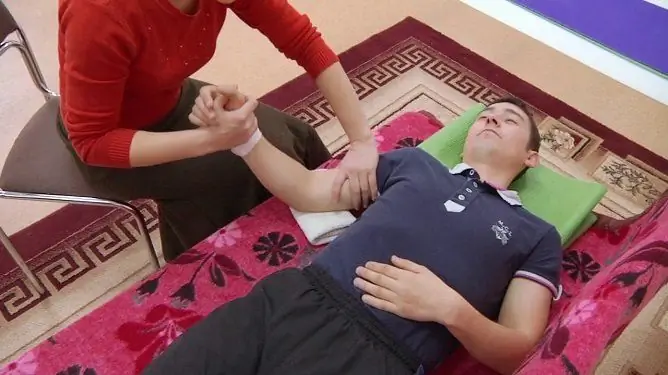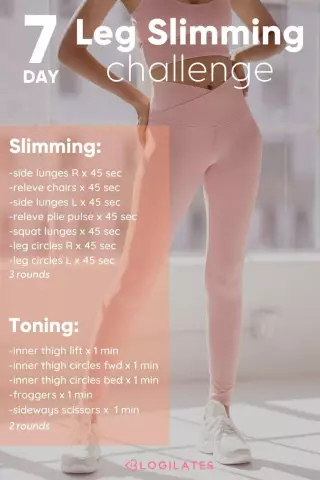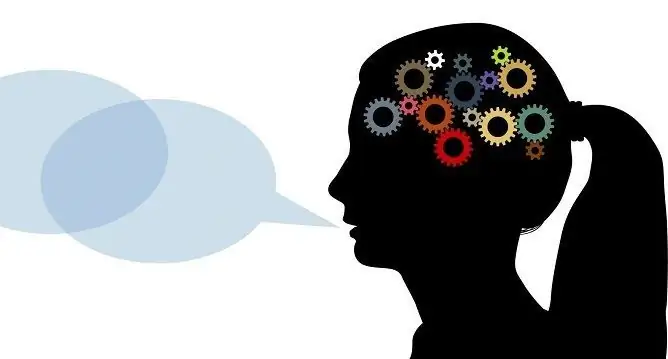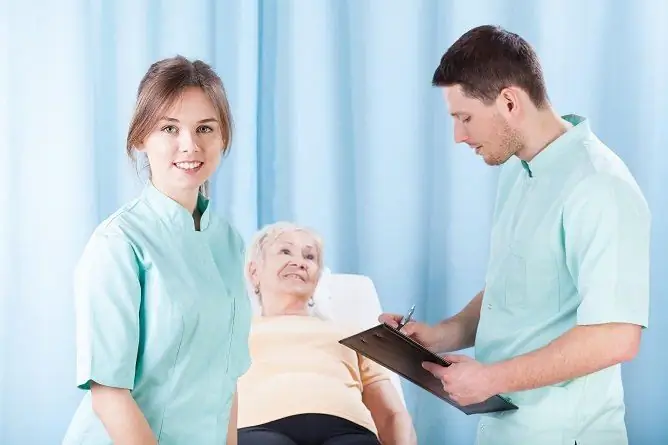- Author Rachel Wainwright [email protected].
- Public 2023-12-15 07:39.
- Last modified 2025-11-02 20:14.
Physiotherapy exercises (exercise therapy) after a stroke
The content of the article:
- The main tasks of exercise therapy after a stroke:
- Exercise therapy and bed rest
- Moderately extended semi-bed rest
- Exercise therapy after a stroke: a set of exercises at home
- Bubnovsky method
- Video
Exercise therapy after a stroke is one of the important components of rehabilitation, which, like drug therapy, affects the prognosis. Rehabilitation measures after an ischemic or hemorrhagic stroke should be early and aggressive. They should be started immediately after the patient's condition has stabilized (usually for 2-3 days) and carried out daily for several months.
Regular exercise not only allows you to restore or improve motor functions, but also helps to reduce the risk of complications (congestive pneumonia, bedsores).

Exercises begin in the early post-stroke period
The main tasks of exercise therapy after a stroke:
A stroke often leaves the right or left side of the body paralyzed. Regular exercises in medical gymnastics help to activate the reserve neurons of the brain and thereby partially or completely compensate for the manifestations of neurological deficit.
The main tasks of physiotherapy exercises after a stroke are:
- prevention of complications associated with prolonged bed rest (muscle atrophy, congestive pneumonia, thromboembolism, progression of heart failure, bedsores);
- normalization of muscle tone;
- improvement of microcirculation and metabolism in tissues;
- restoration of motor activity;
- prevention of the formation of muscle contractures;
- improving the functions of internal organs;
- restoration of speech function;
- restoration of fine motor skills of the hands.
It is desirable to combine exercise therapy with other methods of rehabilitation, such as kinesiotherapy, massage, occupational therapy, social and psychological adaptation. Therefore, in the hospital, rehabilitation treatment is carried out by a team of specialists (psychologist, nurse, massage therapist, exercise therapy instructor, psychologist, speech therapist, kinesiotherapist), working under the guidance of a neurologist. Relatives of patients are actively involved in carrying out rehabilitation measures.
Exercise therapy and bed rest
The early recovery period lasts up to three months from the time of the brain accident. Some patients spend this time or part of it, observing strict bed rest. First, you need to give them the correct body position and change it - this is necessary for the prevention of congestion and pressure ulcers.
After a stroke, muscle tone is disturbed, as a result of which the limbs occupy an incorrect position. For example, a paralyzed leg turns outward, the foot begins to droop. Spastic paralysis of the upper limb leads to the fact that it bends at the wrist and elbow joints, and the fingers are clenched into a fist. If you do not give the patient the correct body position on a healthy side or back, then over time he will develop muscle contracture, which will be very difficult to correct, and in some cases even impossible.
In the first days after a stroke, the left or right arm and leg do not work well. Therefore, the patient is practically unable to perform active movements with them. To correct the situation during this period, a set of exercises for bedridden patients is performed, based on passive movements, that is, performed not by the patients themselves, but by an exercise therapy instructor or under his guidance by their relatives.
Depending on the type of joint, the following types of passive movements can be performed in it:
- rotation (rotation);
- adduction and abduction;
- flexion and extension.
At first, the amount of movement performed should be minimal. It is gradually increased, but does not exceed the physiological amplitude for the developed joint. Each movement is repeated 10-15 times. Passive hand exercises are performed first in the shoulder joint, then in the elbow, wrist, and then in the small joints of the hand. For the legs, they should be performed, starting with the hip joint, then moving on to the knee, ankle and joints of the toes.
Respiratory gymnastics is very important for the prevention of congestion in the lungs in bedridden patients. In addition, its implementation allows you to increase blood oxygen saturation and thereby reduce brain hypoxia, improve metabolic processes in it. The main exercises of breathing exercises are:
- take a deep breath and then exhale slowly through tightly closed lips;
- exhaling slowly through a cocktail tube into a glass of water;
- inflating balloons.
Patients should perform these exercises at least 10 times a day.
An important stage in physical rehabilitation is the implementation of not only physical, but also mental exercises. Each movement has its own muscle memory. Therefore, if the patient's right half of the body does not work, then it is necessary to mentally imagine how the right arm and leg bend, the fingers and toes move. Repeated repetition of such exercises contributes to the fact that in the future it is much easier to restore the movements of the paralyzed limb. In addition, this technique allows the patient to form a clear goal, which also contributes to the acceleration of recovery.

To restore fine motor skills, exercises with children's designers are useful.
Moderately extended semi-bed rest
At the next stage, the rehabilitation program is expanded. In addition to passive ones, it also includes active exercises that the patient performs on his own. If the patient is not yet allowed to sit down and get up, then he performs a set of exercises lying down:
- clenching and unclenching the fingers;
- rotation of the fists in the wrist joints in one direction and the other;
- flexion and extension of the upper limbs in the elbow joints;
- raising the straightened arms above the head and lowering them along the body, that is, only the shoulder joints work;
- swing with straightened arms to the sides;
- flexion and extension of the toes;
- pulling the feet towards yourself and lowering them down;
- slow flexion and extension of the legs in the knee joints, while the feet are not lifted off the bed;
- bending the legs in the knee and hip joints, spreading them to the sides and slowly returning to their original position;
- a slow turn of the torso in one direction or the other in the supine position;
- lifting the pelvis over the bed with emphasis on the feet, elbows, shoulder blades and the back of the head.
This complex should be performed 3-4 times a day. The number of approaches depends on the patient's condition. Initially, each exercise is repeated 3-5 times. With good tolerance to physical activity, the number of repetitions, gradually increasing, is brought to 15-20.
After the patient is able to take a sitting position, and this is allowed to him by the attending physician, physiotherapy exercises become even more active. To the above exercises, add the following, performed in a sitting position:
- head tilts from side to side;
- rotation in the cervical spine, first in one direction and then in the other direction;
- sitting on a bed without support under the back and with legs lowered (the duration of this exercise is at first 1-3 minutes, then gradually increases);
- back bends, leaning on the handrail of the bed;
- sitting on the bed with legs stretched forward and resting on hands, alternately raise the legs above the surface of the bed and slowly return to their original position;
- in a reclining position (several pillows are placed under the back), one or the other leg is slowly pulled to the chest (if necessary, you can help with your hands).
In addition, patients should do hand exercises as often as possible. It is quite simple and is based on sorting through small children's toys, collecting and disassembling figures from a Lego-type constructor, classes with mosaics. Also, to improve fine motor skills of the brush, drawing, modeling, origami, and embroidery are recommended.
The proposed complex of exercise therapy after a stroke is common. If necessary, it can include other exercises aimed at restoring speech, friendly eye movements, writing and other functions.
Exercise therapy after a stroke: a set of exercises at home
Physiotherapy started by a patient who has suffered an acute cerebrovascular accident in the hospital must continue without fail after discharge from the hospital. You can ask the instructor to record a video of exercise therapy after a stroke on a disc or USB drive (flash drive) - such a video will help you do exercises at home in the correct technique, in the right order and without omissions.
The complex of exercise therapy after a stroke at home includes exercises performed while lying, sitting and standing. All exercises in a standing position should be performed with the obligatory safety of the patient by an instructor, a relative, or with the use of additional support. An approximate set of such exercises:
- the patient tries to maintain balance in a standing position with hands down;
- swing your hands;
- circular head movements;
- squats;
- tilts of the body back and forth and left and right;
- turns of the body to the right and left;
- swing your legs.
After the patient learns to stand for a long time and maintain balance, and his muscles get stronger, the motor load is expanded again by adding walking.
Initially, the patient goes through segments no more than 10-15 meters long with the obligatory help of other persons or additional support. Then this distance gradually increases, and the support weakens as much as possible.
In the future, patients who have suffered a stroke are recommended long walks in the fresh air with a gradual increase in the pace of walking. Such physical activity is very useful for the cardiovascular system and can be practiced for as long as desired, preferably for life - daily walking in the fresh air, opposing physical inactivity, serves as an effective prevention of many diseases.
Bubnovsky method
The basis of rehabilitation treatment according to the method of Dr. Bubnovsky is kinesiotherapy, that is, treatment with movement. At the same time, unique simulators with antigravity and decompression functions are used, which facilitate the execution of movements by patients with limited functions after a stroke.

Regular exercises according to the Bubnovsky method contribute to the rapid recovery of motor functions
The Bubnovsky method consists in creating an individual training program for each specific patient, which takes into account the necessary parameters - the general state of health, the stage of the disease, features of impaired motor function, personality characteristics, and motivation.
Regular exercises according to the Bubnovsky method help to improve joint mobility, restore the elasticity of the ligamentous apparatus and muscles. This contributes to the relief of pain syndrome, improvement of trophism of soft and hard tissues, gradual restoration of motor functions.
Physical therapy plays no less, and sometimes even more, in the patient's recovery and prevention of stroke recurrence than drug therapy. It should fit tightly into the life of every stroke patient.
Video
We offer for viewing a video on the topic of the article.

Elena Minkina Doctor anesthesiologist-resuscitator About the author
Education: graduated from the Tashkent State Medical Institute, specializing in general medicine in 1991. Repeatedly passed refresher courses.
Work experience: anesthesiologist-resuscitator of the city maternity complex, resuscitator of the hemodialysis department.
Found a mistake in the text? Select it and press Ctrl + Enter.






